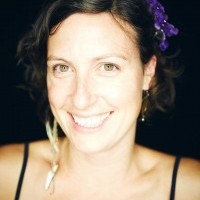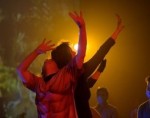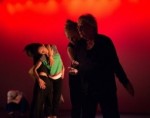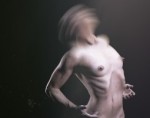
Photo: Herman Sorgeloos
Architectural Tuning
by Megan Bridge
The house lights are still up, but suddenly the audience makes a collective decision to quiet down. Nothing else has changed, yet there is a hush of anticipation. Several minutes pass like this. A violin is being tuned somewhere off stage. The lights abruptly drop, a door opens, then closes behind violinist Amandine Beyer as she enters the dark space. As our eyes slowly adjust to the dim ambient light from the large windows in the upstage wall of the FringeArts theater, Beyer plays through most of the five movements of Bach’s Partita No. 2
, downstage-center, in the dark. Her bow trips silkily over the strings as she elides some phrases and sharply accents others, sometimes biting in to the sound, sometimes slipping along top.
All five movements in Partita No. 2 are dances: allemande, courante, sarabande, gigue, and chaconne. Beyer plays all five, but breaks off abruptly and runs out of the theater, still in the dark, before finishing the chaconne (probably the best known of the sections). Suddenly the space is awash with white light. Anne Teresa De Keersmaeker and Boris Charmatz enter. Immediately, they are skipping, jumping through the space in complete silence, following the curving pathways of thinly drawn, overlapping circles that look like chalk lines on the floor. A vertical rectangle of light is projected on the upstage-right wall. Sometimes traveling in parallel, sometimes crossing each other with near misses, the dancers’ relaxed, open performance quality at times explodes with a precision that is deeply gratifying to behold. They walk, skip, run, and find their way into gestures and movements that seem to grow from underneath them. Jumping, Charmatz leaves the ground effortlessly. In another context his movements might be called “tour en l’air” or “pas de chat,” but that vocabulary has no place here. This is exuberance embodied. I wonder if the dancers’ occasional utterances (a light groan, a breathed whistle) are cues or if they are responses to their own kinetic energy. They’re both wearing brightly colored sneakers, which make satisfying sounds as their feet skim the floor more slowly now, in small skips, shunts, steps, slides.
A mysterious tone sounds from off-stage, and now the dancers are humming. Actually, it’s hard to tell if they are humming or singing in
solfège. I recognize this melody but I’m not sure why. Harmonizing under their breath, De Keersmaeker and Charmatz keep time with their pedestrian, playful, propulsive movement. I realize that the “doorway” of light has been gradually traversing the upstage wall, like an artificial sun that rises, keeps time through the day, and will eventually set. Charmatz and De Keersmaeker leave the space.
Very soon, all three performers re-enter. Beyer stations herself upstage center now, at the apex of two overlapping circles, and Charmatz settles on the floor next to Beyer, leaning against the upstage wall. Beyer begins again, at the top of the Partita. De Keersmaeker performs a solo, moving up and down along the center line of the stage, her skipping steps precisely timed with the music. I’m suddenly aware that this must be a much smaller space than the performers are used to. De Keersmaeker alters the size of her skips; it’s clear she’s a bit uncomfortable with the way the space is affecting her timing (less space to travel = more time to play with, which translates into a sometimes precarious hesitation), but her presence is completely open, human, embedded in the moment. When she comes downstage, she grins widely into the countenance of a sleeping older gentleman whose wife laughingly nudges him awake. Turning upstage again, back and forth, she’s almost goofing on the sound, smiling as she dances along with the familiar strains that she plays with so expertly.
Charmatz stands slowly, subtly shadowing De Keersmaeker’s movement at first, then jumping in, skipping, tripping, jerking gracefully. (How is that possible? Charmatz makes it so). There is such sensitivity in their movement … a slow spiral, the softness of their hands open to each other, their throats open to the ceiling, their gaze open to the space, to us gazing back.
More vibrant again, they audibly count their backward skips, and I realize this is a repeat, we saw this movement in silence at the beginning of the dance. The musical section ends, the dancers wait, blink, squeezing their eyes shut as sweat drips in. Beyer moves the tuning pegs of her instrument, somehow intuiting, without sound, how to bring the pitch back to where she wants it. Again, they begin, still repeating the movement, section by section, that we’ve seen in silence. It’s so pleasurable to see this…how could it have been in silence before? The smallest flicks and shunts link precisely to the detail of the score. The singing returns, definitely solfège, following the underlying harmonic structure of the music. I am moved profoundly as their voices link up with the violin here, and I know I’m not alone: In my peripheral vision, without taking my focus off the stage, I see three people wiping tears from their eyes. It’s as though the memory of their earlier singing folds back into this moment, creating an infinite feedback loop of listening and perception.
In a talkback after the show, De Keersmaeker explains that her interest lies in “finding frameworks that are an invitation to challenge perception.” This work does that, simultaneously engaging the viewer visually, aurally, and kinesthetically. Partita 2 asks us not just to note the passing of time, but to participate kinesthetically in time’s ticking, to participate through memory and image, in time’s folding in on itself through a structure that is built on repetition with a difference. The commanding architecture of Bach’s score, with all its beautiful filigree, is broken open, taken apart, and put back together again, the structures of the dance and the music fortifying each other. The depth with which De Keersmaeker, Charmatz, and Beyer find joy in their collective task is profound. I think of Marcel Duchamp’s quote, “Art is a game between all people of all periods.” De Keersmaeker’s move in the game is a tuning, an opening, an invitation to work, to play, to listen and be moved.
__
For other perspectives on
Partita 2, please see Lynn Brooks's article
here and Kat Sullivan's meditation
here.
Partita 2, Anne Teresa De Keersmaeker, Boris Charmatz, and Amandine Beyer, FringeArts, November 1, 2015,
www.fringearts.com
By Megan Bridge
November 4, 2015











